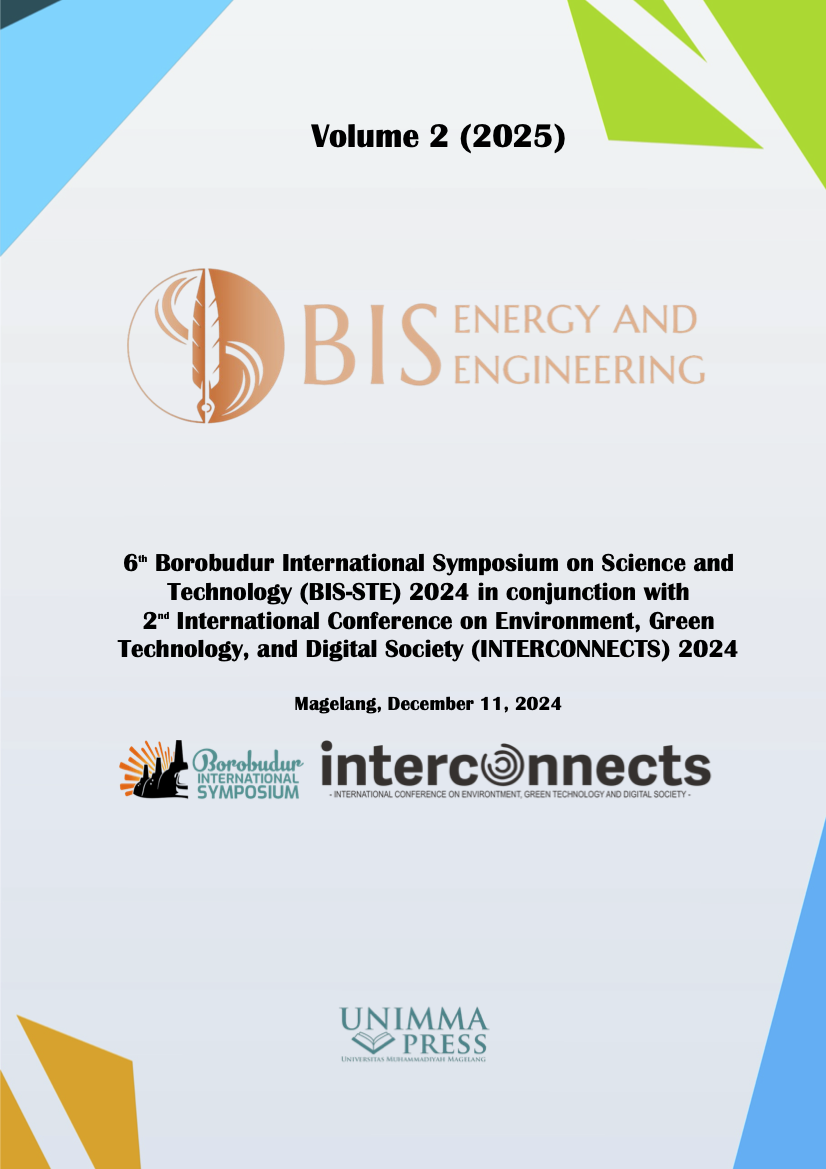Enhanced swelling hydrogel of cellulose by adding fly ash
Keywords:
Cellulose, Fly Ash, Hydrogel, Swelling ratioAbstract
Coal combustion as a source of steam power generation produces waste in the form of fly ash, which is an environmental pollutant. Fly ash's properties are influenced by its mineral concentration, which implies that it differs significantly depending on the coal source. In this work, an environment friendly hydrogel is made from cellulose and fly ash to utilize coal waste. Environment-friendly hydrogel is used in various fields of science, such as health and agriculture. The preparation process involves two cellulose derivatives, Sodium Carboxymethyl Cellulose (CMC-Na) and Hydroxyethyl cellulose (HEC), in 2% distilled water with a 3/1 ratio of CMC-Na/HEC. Citric acid (CA) is a crosslinking agent, and it is commonly used in various cellulose derivatives because it has non-toxic properties. The polymerization occurs during heating in an oven at 80℃ for 8 hours. The percentage swelling ratio and FTIR measurements investigate the addition of CA variation at the range of 1.75%-5% and the variation of adding silica-based fly ash such as sodium silicate and nanosilica. The results showed that the best percentage swelling ratio with the lowest CA content and 5% nanosilica gave the highest swelling ratio at 5800%. Adding silica-based fly ash material affects the swelling ratio of the hydrogel.
References
[1] G. E. Monitor, “Boom and Bust Coal,” 2024.
[2] T. Hemalatha and A. Ramaswamy, “A review on fly ash characteristics – Towards promoting high volume utilization in developing sustainable concrete,” J. Clean. Prod., vol. 147, pp. 546–559, 2017, doi: 10.1016/j.jclepro.2017.01.114.
[3] P. Goswami, J. Mathur, and N. Srivastava, “Heliyon Silica nanoparticles as novel sustainable approach for plant growth and crop protection,” Heliyon, vol. 8, no. June, p. e09908, 2022, doi: 10.1016/j.heliyon.2022.e09908.
[4] I. Teknik, “Penyisihan Warna Pada Limbah Cair Industri Sasirangan Dengan Adsorpsi Karbon Aktif Andy Mizwar 1) ,Nurin Nisa Farah Diena,” vol. 13, no. 1, pp. 11–16, 2012.
[5] N. Najwa, A. Malek, A. H. Jawad, K. Ismail, R. Razuan, and Z. A. Alothman, “International Journal of Biological Macromolecules Fly ash modified magnetic chitosan-polyvinyl alcohol blend for reactive orange 16 dye removal : Adsorption parametric optimization,” Int. J. Biol. Macromol., vol. 189, no. June, pp. 464–476, 2021, doi: 10.1016/j.ijbiomac.2021.08.160.
[6] E. T. Wahyuni, A. Prasetya, and S. U. Yogyakarta, “The Effect of Coal Fly Ash Crystallinity toward Methyl Violet Adsorption Capacity,” vol. 10, no. 1, pp. 8–14, 2010.
[7] S. Xu, Jingyuan; M. Boddu, Veera; X. Liu, “Produced By Cellulose Derivatives Crosslinked With Citric Acid , Succinic Acid And Sebacic Acid,” vol. 56, pp. 49–54, 2022.
[8] T. Fekete, J. Borsa, E. Takács, and L. Wojnárovits, “Synthesis of cellulose derivative based superabsorbent hydrogels by radiation induced crosslinking,” Cellulose, vol. 21, no. 6, pp. 4157–4165, 2014, doi: 10.1007/s10570-014-0445-6.
[9] V. S. H. Sujoto, I. Tangkas, W. Astuti, S. Sumardi, S. N. A. Jenie, A. P. C. Tampubolon, Syamsumin, A. P. Utama, H. T. B. M. Petrus, Y. Kusumastuti, “Penentuan kondisi optimum pembuatan silica gel menggunakan silika geothermal dengan metode sol-gel,” J. Rekayasa Proses, vol. 17, no. 2, pp. 122–128, 2023, doi: 10.22146/jrekpros.77696.
[10] J. M. Chem, “Synthesis of complex nanomaterials via Ostwald ripening,” pp. 4843–4851, 2014, doi: 10.1039/c3ta14203e.
[11] C. Demitri, “Novel Superabsorbent Cellulose-Based Hydrogels Crosslinked with Citric Acid,” 2008, doi: 10.1002/app.
[12] Y. Zhang, X. Tian, Q. Zhang, H. Xie, B. Wang, and Y. Feng, “Hydrochar-embedded carboxymethyl cellulose-g-poly(acrylic acid) hydrogel as stable soil water retention and nutrient release agent for plant growth,” J. Bioresour. Bioprod., vol. 7, no. 2, pp. 116–127, 2022, doi: 10.1016/j.jobab.2022.03.003.
[13] K. Dharmalingam and R. Anandalakshmi, “International Journal of Biological Macromolecules Fabrication , characterization and drug loading ef fi ciency of citric acid crosslinked NaCMC-HPMC hydrogel fi lms for wound healing drug delivery applications,” Int. J. Biol. Macromol., vol. 134, pp. 815–829, 2019, doi: 10.1016/j.ijbiomac.2019.05.027.
[14] H. Dai and H. Huang, Enhanced swelling and responsive properties of pineapple peel superabsorbent hydrogel by the introduction of carclazyte. 2017. doi: 10.1021/acs.jafc.6b04899.
[15] N. M. Puspawati and K. Ratnayani, “Kajian Pengaruh Variasi Konsentrasi Asam Sitrat Terhadap Kekuatan Gel Produk Gelatin Kulit Ayam Broiler Dikaitkan,” no. June, 2020, doi: 10.24843/JCHEM.2016.v10.i01.p16.
[16] T. Gong, Y. Hou, X. Yang, and Y. Guo, “International Journal of Biological Macromolecules Gelation of hydroxyethyl cellulose aqueous solution induced by addition of colloidal silica nanoparticles,” Int. J. Biol. Macromol., vol. 134, pp. 547–556, 2019, doi: 10.1016/j.ijbiomac.2019.05.069.
[17] S. Basan, “Thermal degradation of polymers and polymer blends,” Hacettepe J. Biol. Chem., vol. 1, no. 42, pp. 143–143, 2014, doi: 10.15671/hjbc.20144210828.
Downloads
Published
Conference Proceedings Volume
Section
License

This work is licensed under a Creative Commons Attribution-NonCommercial 4.0 International License.

